

One of the biggest misconceptions (there were so many!) that got destroyed when I went to art school is the one that says: ‘in order to be a proper artist, you need to be able to draw realistically’. Drawing is surrounded by a strange aura that makes people assume it’s a talent you’re either born with, or without.
The truth is, drawing is a discipline that’s incredibly wide, of which, being able to render something realistically is only one aspect. If we think of drawing as a language – visual language – then it makes sense that it’s fundamental to any creative act, whether it’s in architecture (draft plans are some of the most beautiful drawings around), geography (maps are drawings), programming (flowcharts and mindmaps are quite gorgeous), fashion (mmm… fashion illustrations), chemistry (the double helix of a dna strand is an incredibly beautiful drawing), electrical engineering (think of the lines of a complicated circuit), etc. Drawing is one of the most basic, universal, forms of communication.
 Sketch, Suhaila Hashim, 41 x 29.5cm (image from Pelita Hati)
Sketch, Suhaila Hashim, 41 x 29.5cm (image from Pelita Hati)
Contrary to what we were taught in school, everyone can draw, and everyone can draw well. I think that one of the reasons for the gap of understanding between the general public and contemporary art is that many people continue to believe that drawing means only one thing – being able to replicate that apple on the table accurately on a piece of paper. Everyone goes through that lesson in school, some do well, most don’t, and the ones that get the C grade then decide forever after that ‘oh, I can’t draw’ or worse ‘I’m not artistic wan la’. We are not taught to look at drawing (or art) in more expanded terms, and so many people continue to view art through the narrow lens they were first educated in (i.e does it get an A, B or C grade?)
Catching Sculpture Studies: 3d to 2d at Pelita Hati House of Art reminded me of how fundamental the process of drawing is to all disciplines. The exhibition collects together a big range of drawings, or studies, from contemporary Malaysian sculptors. There are some notable omissions (Sharmiza Abu Hassan, Tengku Sabri Ibrahim, Mad Anuar Ismail for example), but the show is truly contemporary (all the works shown are dated 2009) which means that it represents a good behind-the-scenes look at the range of sculpture practice today.
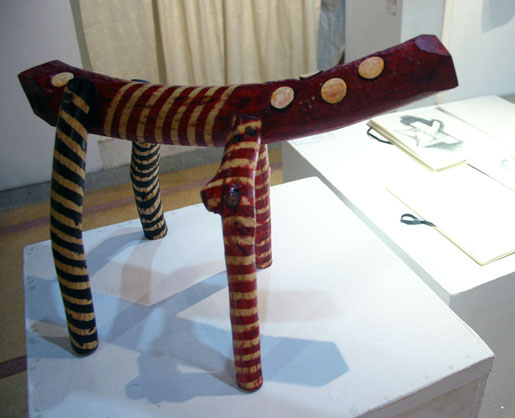
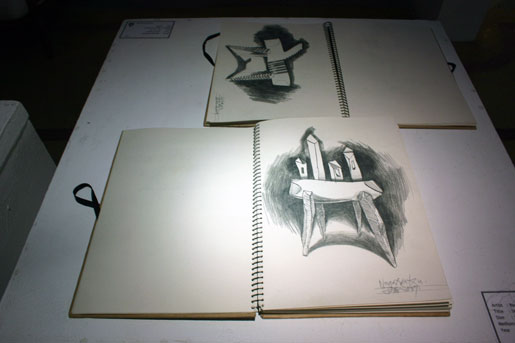 Top: Running Forest – Model, 2009, Ramlan Abdullah, 32 x 40 x 30cm
Top: Running Forest – Model, 2009, Ramlan Abdullah, 32 x 40 x 30cm
Bottom: Sketch Book 1 and 2, 19 x 27cm each – for more info about his work, please visit his website.
First of all, the idea of the exhibition itself must be commended. Compared to painting, much less attention has been given to Malaysian sculpture. In Part II of her introductory talk on Contemporary Art in Malaysia (it was titled ‘Painters and Sculptors’, and held on 19 April 2009 at Galeri Petronas. ARTERI wrote on Part I here.), Beverly Yong said as much. However, she also noted that there seemed to be less ‘baggage’ in sculpture practice, whereas painting has always had to grapple with the problem of borrowing from the Western art tradition. A quote from her curatorial notes on Formative (a 2003 sculpture exibition at Valentine Willie Fine Art): ‘Unlike oil painting, with its problematic dependence on Euro-American traditions, sculpture is an ancient and universal art form. Its more direct relationship to the object gives it the flexibility to absorb localised forms and themes.’
The works in 3d to 2d range from sketch books, finished drawings, collages and paintings to maquettes (this means a small scale model of the original sculpture design). The visual diversity shows us the different strategies and processes which sculptors use in their work. Here, we can see drawing being used as a tool to explore concepts and forms, rather than being an end in itself. It breaks down the idea of drawing as merely technical skill/god-given talent, and returns it to what it really is: an intellectual exercise that marries form and function.
There are some outstanding works in the show, including 4 pieces by Raja Shariman (the creator of the inimitable and epic Gerak Tempur series) – the drawings contain all the refinement and energy of his metal works. (A show of his new works is being planned for next month at Galeri Petronas – do not miss it)
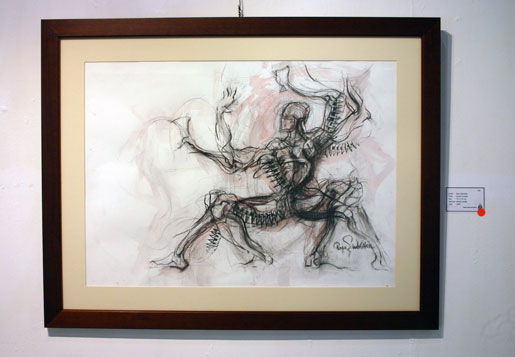 Gerak Studies, 2009, Raja Shariman, 73.5 x 53cm
Gerak Studies, 2009, Raja Shariman, 73.5 x 53cm
That said, the exhibition is let down by a lack of curatorial direction and further information on the artists or their works. I was lucky enough to have Pelita Hati’s Raja Annuar walk me through the show, and the information I gained lent so much insight to what was on display. I learnt that one particular sculptor working in ceramics was experimenting with making his own bone china by mixing fired animal bone with clay. Samples of the materials were laid out, but without someone telling me what they were, I had no way of knowing on my own. Artist bios and some short statements would have gone a long way. In exhibitions like this, so much is about the context and practice of sculpture – background information helps with viewer appreciation and understanding.
 Bones and little sample blocks of handmade bone china. It’s cow bones, if you want to know.
Bones and little sample blocks of handmade bone china. It’s cow bones, if you want to know.
Raja Annuar tells me that this is a precursor to a proper sculpture show that will open on 28 May. He plans to run a series of artists talks as well as have video documentation on their different processes. One of the reasons why sculpture is under-developed locally is undoubtedly due to logistic issues – the costs of running a fully equipped foundry, for example, are very high, in addition to requiring professional expertise. When I was in art school, I did one simple aluminium lost wax casting that took me 2 long months and hours of elbow grease.
Sculpture is fun and tactile. Understanding the complex processes that go into making it will make the practice accessible to more people. That’s what we need more of.
More about Sculpture Studies: 3d to 2d at Pelita Hati’s bulletin blog. The exhibition ends 6 May 2009, so you still have a couple of days to catch it.
Links to a local bronze casting foundry here, and Itchyhands, a metalsmithing studio here.
(SC)
~
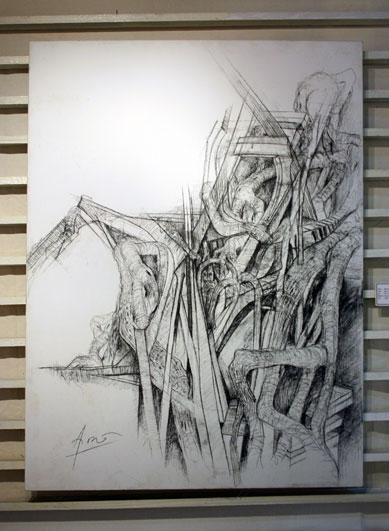 Akar series, 2009, Mohd Afifee Ibrahim, 2009, 91.5 x 122.5cm – the artist has been experimenting with creating a new material consisting of resin and wood.
Akar series, 2009, Mohd Afifee Ibrahim, 2009, 91.5 x 122.5cm – the artist has been experimenting with creating a new material consisting of resin and wood.
~
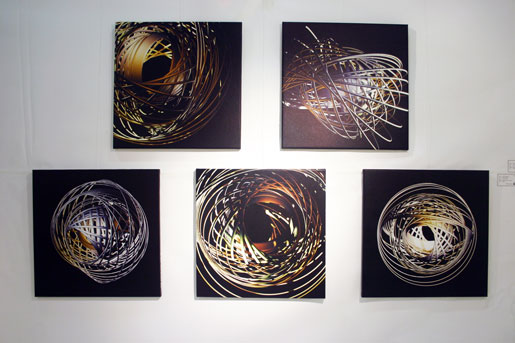 Involute Study 1 – 5, 2009, Abdul Multhalib Musa, 61 x 61.5cm each – the sculptor is well-known for generating his complex modular forms on the computer and then manufacturing them in precision cut steel. Fairly recent review of his work here. More at his website here.
Involute Study 1 – 5, 2009, Abdul Multhalib Musa, 61 x 61.5cm each – the sculptor is well-known for generating his complex modular forms on the computer and then manufacturing them in precision cut steel. Fairly recent review of his work here. More at his website here.
~

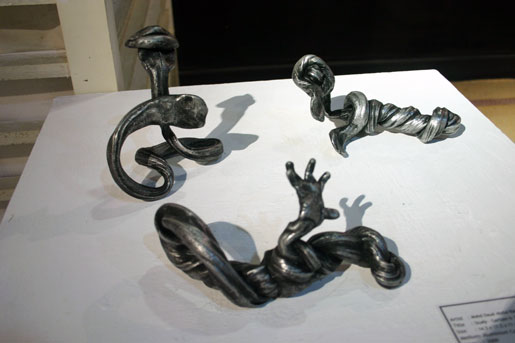 Top: Sssyh Study, 2009, Mohd Daud Abdul Rahim, 78 x 58cm
Top: Sssyh Study, 2009, Mohd Daud Abdul Rahim, 78 x 58cm
Bottom: Study – Garisan & Tenaga 2, 3 and 4, 2009, Mohd Daud Abdual Rahim
~
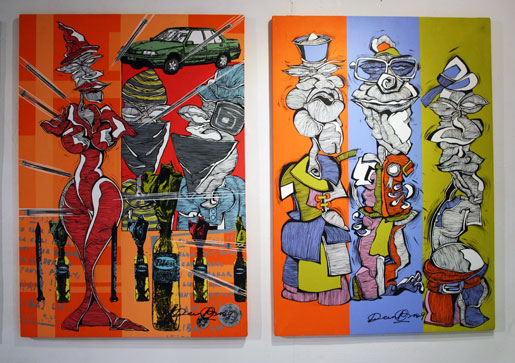 Molotov Cocktail (left) and 3 Kapten (right), 2009, Zainuddin Abindinhazir, 61 x 91.5cm each – two in a series of heavily political works. I suspect these are referring to the murder of mongolian model Altantuya Shaaribu. The artist has worked with well-known painter and installation artist Zulkifli Yusoff. The influence is quite clear.
Molotov Cocktail (left) and 3 Kapten (right), 2009, Zainuddin Abindinhazir, 61 x 91.5cm each – two in a series of heavily political works. I suspect these are referring to the murder of mongolian model Altantuya Shaaribu. The artist has worked with well-known painter and installation artist Zulkifli Yusoff. The influence is quite clear.
~
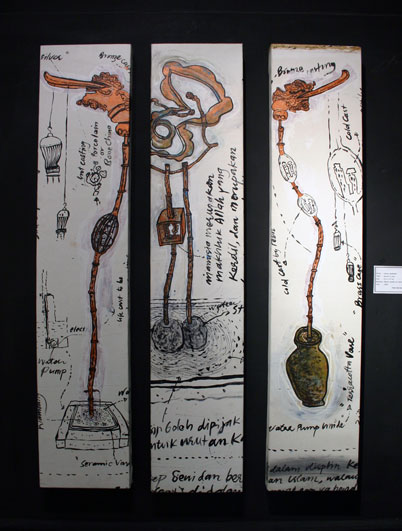 Sketch, 2009, Zainon Abdullah, Mixed Media on Canvas, 20.5 x 101cm each
Sketch, 2009, Zainon Abdullah, Mixed Media on Canvas, 20.5 x 101cm each
~
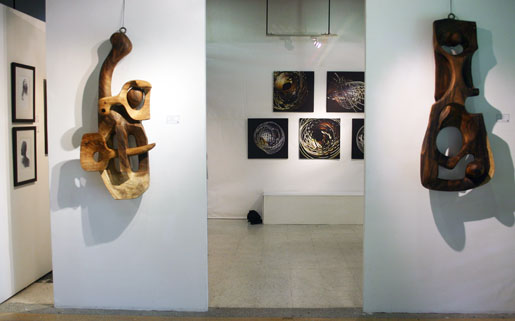 Two maquettes by Romli Mahmood (‘Fossils Studies for Trans-evolutions Series 1 and 2’) – the pieces are joined together using dowels (a piece of round wood), a joining technique much stronger and longer-lasting than nails.
Two maquettes by Romli Mahmood (‘Fossils Studies for Trans-evolutions Series 1 and 2’) – the pieces are joined together using dowels (a piece of round wood), a joining technique much stronger and longer-lasting than nails.
Sorry, the comment form is closed at this time.
That Gerak Tempur drawing looks very stunning. No wonder it has already been snapped up.
Incidentally I saw a contemporary drawing show today. Do have a look at some images: http://www.mca.com.au/default.asp?page_id=10&content_id=4764
It was mostly made up of young artists. Maybe this is why a lot of the works were conceptual drawings… or meta drawings, gosh… For eg, one artist ordered a coffee everyday or something, and asked each barista to make a drawing on the white foam, making it a ‘collaborative’ drawing project. Another work was a biomorphic form carved from hundreds of Staedtler pencils stuck together, and placed on top of a ‘plinth’ of stacked A1-sized paper. Yet another work was a three-channel video projection of elderly people at a drawing class, obviously drawing the person who was filming them.
Maybe I’m just a boring painter but the works that excited me the most were the ones that displayed a pure joy in the activity of drawing. Like the guy who drew kooky images of bearded men with his humble ballpoint pen, & the woman who did a funny Daniel Clowes-type comic strip that made fun of the art world.
There was another triptych of drawings by Raja Shariman which were equally brilliant. (Red dots on those as well). I’ve been saving my pennies in the hopes of one day getting one of his works.
Somehow I find that using humble materials like normal paper and pen allows me to be more free with drawing. The pressure of a beautiful sheet of 300gsm acid free is too much.
That’s why I’ve abandoned usage of those overpriced (but oh so sexy) Moleskines and have been a happy user of 888 (the bigger version of 555) notebook for months now. 60sens for 40 pages. Can’t be beat.
Thanks for the drawing link. Meta drawings, huh…
Mohd Daud’s studies remind me of Junji Ito’s horror magnum opus, Uzumaki:
http://www.onemanga.com/Uzumaki/1/39/